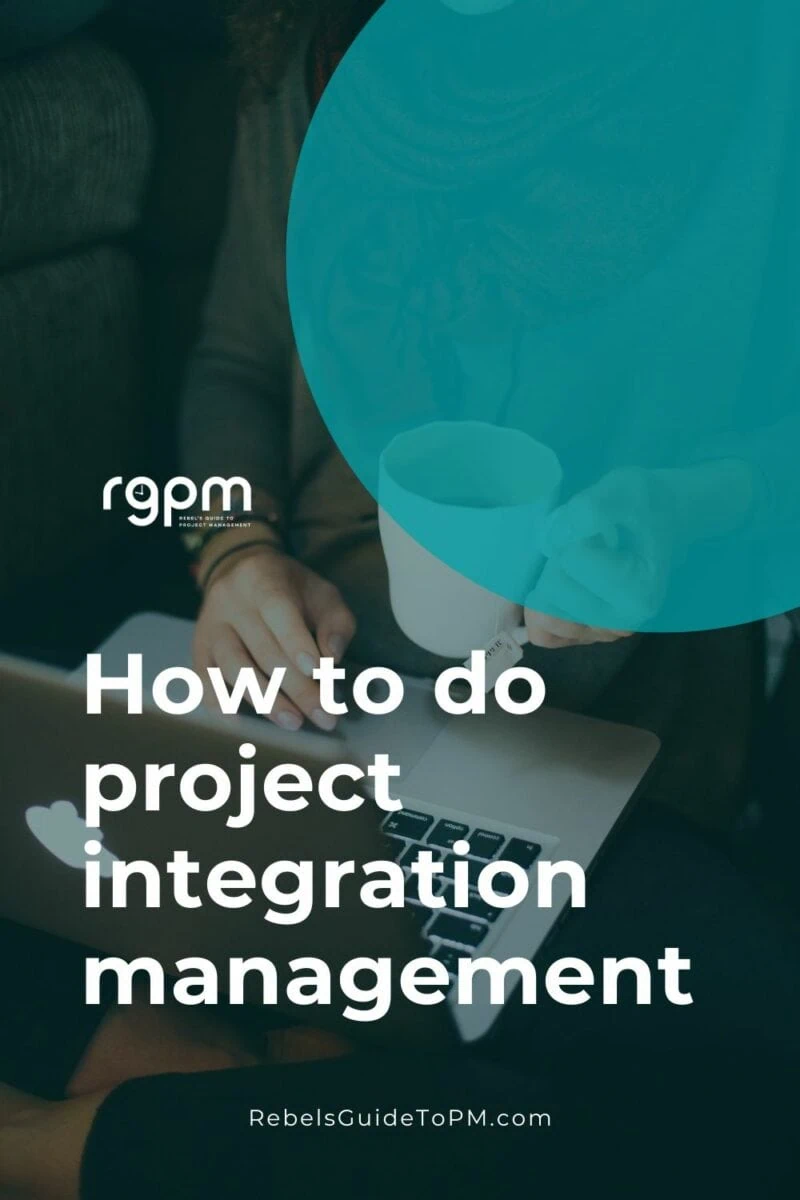Project Integration Management: Tips for a Successful Project
This blog is reader-supported. When you purchase something through an affiliate link on this site, I may earn some coffee money. Thanks! Learn more.
Have you ever started a project and thought: how is all this going to come together?
It’s a question I get asked a lot by the project managers I mentor because, frankly, the beginning of a project is an unsettling time. You don’t know enough to pull it all together. But it does all come together in the end.
The reason a project comes together is because of project integration management: this is what you do as a project manager all day, every day, even if you don’t know it. Your role is to be the glue that holds the project together.
And in PMI terms, that means doing project integration management – a non-job
In this article, I’ll explain what it means, why it’s important and some pitfalls to avoid.
Project integration management is critical for the success of any project. By definition, project integration management includes all the processes and activities necessary to ensure that the various elements of a project are properly coordinated.
This means keeping track of milestones and deliverables, ensuring communication among team members, and managing risks.
If you are studying for the Project Management Professional (PMP)® exam, you’ll want to fully understand this area of leading projects, as it could well come up on your test.
Defining project integration management
Project integration management is the process of combining all aspects of a project into one cohesive whole. This includes everything from developing the project schedule and budget to ensuring that all team members are working towards the same goal.
It’s alignment. It’s joining the dots. It’s the glue.
Managing the fact that all the bits of the project are integrated is important because it ensures that all aspects of the project are aligned and working together towards the same goal. It’s a way to control project work.
Without proper integration, projects can quickly become derailed, causing costly delays and errors. And people don’t know what they are supposed to be doing. You don’t want that.
I think of integration as the main project management activities: the things that I do during a project. For example, facilitating project plan development, tracking project status by consolidating updates from the whole team and making sure potential risks and corrective actions are documented and that someone is doing them, and they don’t conflict with what someone else is doing.
When to do project integration management
Integration activities happen all the way through from kick off to project closure but there are a few key moments to pay attention to:
- When you get started, to make sure all the workstreams, people and deliverables are linked up into a cohesive whole.
- When something changes, to make sure anyone and anything affected by the change is updated and the new plan is shared
- When you buy something, to make sure the procurement management plan is enacted and there is a solid process for bringing new things into the project
- During the risk management process, because new risks mean new actions, budget implications, resource assignment changes etc.
I’ve added that last point, because I’ve worked on too many projects where we bought something because we thought it would solve the problem and actually it ended up needing a lot of customization, or it just wasn’t a fit for the existing infrastructure. Consider that an example of how not to integrate your project.
There are a few key things you can do to ensure proper project integration management.
1. Develop a clear and concise project plan
This should include your project schedule, budget, and objectives. Co-create the plan with the team so everyone has the chance to have their voice heard. When you’re all happy with it, make sure that everyone is aware of what it says and understands their role in the project.
Make sure the plan will actually enable you to meet the project goals and stakeholder expectations.
2. Communicate regularly with all team members
Keep everyone updated on the project’s progress and address any concerns or questions they may have.
This has been the thing that has helped me the most. Most of project management integration is simply talking to everyone and making sure bits of information are passed between team members.
The resource management process will probably add new people into the project as the work progresses, so they should be onboarded so they understand the business case, the rationale for the work and their contribution.
3. Be flexible and adaptable – and bring others with you
Things will inevitably change throughout the course of the project, so be prepared to adjust your plans accordingly.
When that happens, you have to introduce changes, manage a new risk or whatever, keeping people in the loop and bringing everything together again helps make sure your new plans are fully integrated.

The importance of integration
When it comes to managing a project, integration is key. By integrating all aspects of the project, you can avoid duplication of effort and wasted resources. It’s just easier.
Integration happens at all points of the project lifecycle, but I’ve found it most relevant to wear an integration hat during the planning phase.
That’s when you focus on:
- Making sure all the project and phase plans are consolidated and they integrate horizontally and vertically.
- Looking for gaps where dependencies might have been missed
- Listening to the project chatter and zoning in on anything that might be an assumption, constraint, risk or issue.
Document everything in the project charter and project management plan as these are the main documents (in the
Integration ensures that everyone involved in the project understands the big picture and can work together to achieve common goals. You can more easily keep track of all aspects of the project and ensure that everyone is on the same page. Additionally, integration can help you avoid potential conflict and ensure that your project runs smoothly.
If you’re kicking off a new project, now is the time to start thinking about how this integration thing is going to work. Put some time in now to avoid potential problems down the line and ensure that your project is a success.
Tips for ensuring successful project integration
Here are some tips to ensure your project integrates successfully:
- Clearly define roles and responsibilities for each team member in formal document.
- Create a detailed project management plan that sets out how change control and updates are going to work, as these are the areas where you are going to have to re-integrate everything when something changes.
- Create a project schedule that includes milestones and deliverables.
- Communicate regularly with key stakeholders to keep them updated on progress.

Common pitfalls in project integration management
The beginning of a project can be a busy time, and this is when you start to knit all the aspects of the project together. However, this can be easier said than done.
Here are a few common pitfalls that can occur during project integration management.
1. Failing to communicate
This is one of the most common mistakes that can occur during project integration management. If you don’t take the time to properly communicate with everyone involved in the project, it’s likely that misunderstandings and conflict will occur.
That’s on you, as the project manager. You should make sure that there is limited opportunity for miscommunication by having a clear project communication approach (and sticking to it). The project objectives should be front and center of every conversation.
2. Not having a plan for integrating the project
Another common mistake is not having a clear plan or strategy for integrating the various parts of the project. In particular, this means not empowering people to follow the change control process, not having a process for sharing updates and getting status reports, and generally letting parts of the project run away with themselves because you’re not on top of it.
You need:
- A
change management process and a scope statement against which changes can be logged (and an attitude that says no to scope creep) - A RAID log or project notebook for daily tracking
- A way to get updates from the project team.
And I have found it useful to have a project overview statement, a big picture timeline by phase, a roadmap, or something similar that helps visualize the whole project on a single page.
Of course, it’s not just the planning process where you need to integrate. The project execution stage is another part of the project where you’ll be knitting together the various strands all day every day, probably without even realizing that is what you are doing.
3. Underestimating the amount of time and effort required for project integration
Many people underestimate the amount of time and effort required for successful project integration. It’s a lot of work! People constantly go off and do their own thing, make changes without telling you!
If you are trying to keep everything together, set up the project so you are seen as the project leader, not an admin person they can work around.
Making the most of your project management software can help too, because that should mean that people have a common view of what’s going on and there is a baseline to use to keep the project on track.
Best practices for project integration management
Project integration management is all about keeping all the different aspects of your project in sync, and the human resources aligned to the goals throughout the entire project. By following some simple best practices, project managers can make sure that work runs smoothly and avoid any last-minute surprises.
One of the most important aspects of project integration management is communication. Have I made that point strongly enough yet? Make sure to keep all your stakeholders updated on the progress of the project, and be sure to solicit their feedback frequently.
This way, everyone will be on the same page and no one will be caught off guard by unexpected changes. Another important best practice is to manage changes to the project scope, schedule, and budget carefully.
Even if something outside of your control changes, you should still be able to adjust your project accordingly and keep it on track.
Something else to consider is lessons learned for future projects. Reflect back at how you did and pop some lessons in the repository so you remember what to do differently next time.
Common questions
(Not exam questions!)
What is an example of project integration management?
An example of project integration management would be creating a project charter that includes a description of the project, its objectives, and the roles and responsibilities of those involved in the project.
That document will outline how the different parts of the project will be working together to create a cohesive effort that delivers the right end result.
What are some project integration management processes?
The change control process and the project communication management process are examples of two processes that form a big part of project integration management.
Key takeaways
- Project integration management is the process of combining all aspects of a project into one cohesive whole.
- Project integration management is crucial for the success of any project, but it can be difficult to do properly. Avoid common mistakes, such as failing to communicate with all stakeholders or not having a clear plan.
- Put enough time into the communication, collaboration and general talking to others that is required to get and keep everyone on the same page.
